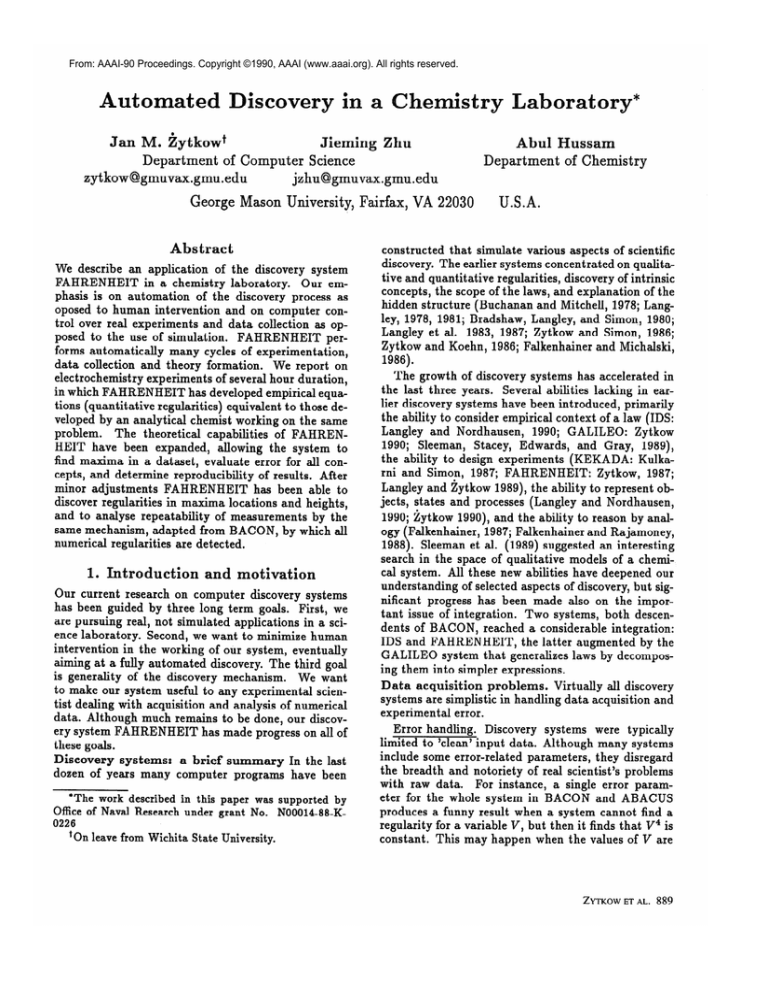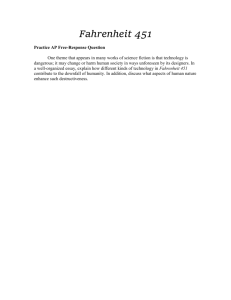
From: AAAI-90 Proceedings. Copyright ©1990, AAAI (www.aaai.org). All rights reserved.
Automated
iscovery
in a Che
Jieming Zhu
Jan M. kytkovvt
Department of Computer Science
zytkow@gmuvax.gmu.edu
jzhu@gmuvax.gmu.edu
George Mason University, Fairfax, VA 22030
Abstract
We describe an application
of the discovery system
FAHRENHEIT
in a chemistry laboratory.
Our emphasis is on automation
of the discovery process as
oposed to human intervention
and on computer control over real experiments and data collection as opposed to the use of simulation.
FAHRENHEIT
performs automatically
many cycles of experimentation,
data collection and theory formation.
We report on
electrochemistry
experiments of several hour duration,
in which FAHRENHEIT
has developed empirical equations (quantitative
regularities) equivalent to those developed by an analytical chemist working on the same
problem.
The theoretical
capabilities
of FAHRENHEIT have been expanded,
allowing the system to
find maxima in a dataset, evaluate error for all concepts, and determine reproducibility
of results. After
minor adjustments
FAHRENHEIT
has been able to
discover regularities in maxima locations and heights,
and to analyse repeatability
of measurements
by the
same mechanism, adapted from BACON, by which all
numerical regularities are detected.
1. Introduction
and motivation
Our current research on computer discovery systems
has been guided by three long term goals. First, we
are pursuing real, not simulated applications in a science laboratory.
Second, we want to minimize human
intervention in the working of our system, eventually
aiming at a fully automated discovery. The third goal
is generality of the discovery mechanism.
We want
to make our system useful to any experimental
scientist dealing with acquisition and analysis of numerical
data. Although much remains to be done, our discovery system FAHRENHEIT
has made progress on all of
these goals.
Discovery
systems:
a brief summary In the last
dozen of years many computer
programs have been
‘The work described
Office of Naval Research
0226
+On leave from
Wichita
in this paper was supported
by
under grant No. N00014-88-KState
University.
aboratory*
Abul Hussam
Department of Chemistry
U.S.A.
constructed
that simulate various aspects of scientific
discovery. The earlier systems concentrated on qualitative and quantitative regularities, discovery of intrinsic
concepts, the scope of the laws, and explanation of the
hidden structure (Buchanan and Mitchell, 1978; Langley, 1978, 1981; Bradshaw, Langley, and Simon, 1980;
Langley et al. 1983, 1987; Zytkow and Simon, 1986;
Zytkow and Koehn, 1986; Falkenhainer and Michalski,
1986).
The growth of discovery systems has accelerated in
the last three years. Several abilities lacking in earlier discovery systems have been introduced, primarily
the ability to consider empirical context of a law (IDS:
Langley and Nordhausen,
1990; GALILEO:
Zytkow
1990; Sleeman, Stacey, Edwards,
and Gray, 1989),
the ability to design experiments
(KEKADA:
Kulkarni and Simon, 1987; FAHRENHEIT:
Zytkow, 1987;
Langley and Zytkow 1989), the ability to represent objects, states and processes (Langley and Nordhausen,
1990; iytkow 1990) and the ability to reason by analogy (Falkenhainer,
1987; Falkenhainer and Rajamoney,
1988). Sleeman et al. (1989) suggested an interesting
search in the space of qualitative models of a chemical system. All these new abilities have deepened our
understanding of selected aspects of discovery, but significant progress has been made also on the important issue of integration.
Two systems, both descendents of BACON, reached a considerable integration:
IDS and FAHRENHEIT,
the latter augmented by the
GALILEO
system that generalizes laws by decomposing them into simpler expressions.
Data acquisition problems.
Virtually all discovery
systems are simplistic in handling data acquisition and
experimental error.
Error handling.
Discovery systems were typically
limited to ‘clean’ input data. Although many systems
include some error-related
parameters,
they disregard
the breadth and notoriety of real scientist’s problems
with raw data.
For instance, a single error parameter for the whole system in BACON and ABACUS
produces a funny result when a system cannot find a
regularity for a variable V, but then it finds that V4 is
constant.
This may happen when the values of V are
ZYTKOW ET AL. 889
c
between 1 and 0 because for each power of V they differ less and less with respect to the unchanging value
of error. Experimental
science not only requires that
the empirical error is determined,
but also that it is
reduced as much as possible.
This involves analysis
of repeatability
and detection of abnormal experimental conditions that invalidate a particular collection of
data, such as a contaminated
electrode.
Data acquisition bottleneck.
As the discovery system&ey
require more input
data. A computer system can be provided with data
in several ways. In the simplest variant, a human operator responds to the system’s request for data by calculating and typing in the appropriate
values. Some
of BACON’s original experiments
were conducted in
this way. When the number of requested experiments
becomes large, it is preferred to use a simulation. Simulation is easy for toy problems, but it is difficult to
build a simulator that would model a situation typical
in a science laboratory
where a variety of unexpected
and unwanted phenomena influence the experiments,
causing error of measurement
and inducing sophisticated measurement procedures.
If we want our discovery systems to deal with these effects, it is easier to
study them in interaction with the real world.
Empirical semantics. The role of operational
seman*
&
tics, which 1’
inks terms in scientific theories with direct
observations and manipulations
(Bridgman,
1927; Carnap, 1936; iytkow,
1982) is negligible in the existing
discovery systems, while it is very important
in real
science.
Especially the use of instruments
has been
disregarded by research on machine discovery.
While the simplistic approach to experimentation
was useful at the early stage of research on discovery
systems, at the present time we may directly confront
the main goal of science, which is developing theories
of the real world in an interaction
with the world. If
discovery systems are going to satisfy the needs of the
experimental scientist, we must spend more time working on real experiments and on processing real data.
Because even a simple discovery in modern science is
based on the analysis of many thousand datapoints,
discovery systems should be ready to handle massive
data rather than few datapoints
on which we tested
our early systems.
in chemistry.
Automation
of the
Automation
thinking processes which we are building into discovery systems must be matched by automation
of the
actual experimentation
and data collection in the science lab. Are scientists getting ready for that? Actually, the automation and computer support in a science
lab has already reached a massive scale, including data
acquisition and data analysis. Recently the robot technology has been tested in the chemistry laboratory on
the tasks of sample preparation,
and in a relatively
short time a number of complex lab operations can
be automated by combination
of simple steps (Sharp,
890 MACHINELEARNING
Whitfield, and Fox, 1988).
To all for whom automation
of discovery looks like
a science fiction, we would like to deliver a practical
proof that it is already possible on a limited scale. This
paper reports our first results. But if it is possible to
use a discovery system as a scientist’s associate, does it
pay to do so ? It depends on the generality of the system. The BACON family of discovery systems, including BACON, IDS, and FAHRENHEIT,
comes off very
favorably on this account.
Not only does each experimental scientist speak in terms of independent and dependent variables, empirical equations, their stepwise
generalization, and their range of application, measurement error, relevant and irrelevant variables, but these
terms refer to a larger part of their laboratory
work.
A reliable discovery system can become a workhorse
that carries out a considerable amount of work in any
science lab.
2. Chemistry
experiments
We selected electrochemistry
as the application area
for a number of reasons. First, the computer operated
sensors and actuators are readily available in a typical
chemistry lab. Second, it is relatively easy to automate various electrochemical
operations
on chemical
samples.
Third, chemists often work with relatively
simple equations, which do not exceed the theorizing
capabilities of the systems in the BACON family.
We report on an automated experiment in differential pulse voltammetry.
Our experiments
parallel an
ongoing research conducted by a chemist working on
construction
of new instrumentation.
This gives us an
opportunity
to compare and verify our results.
Problem 1: Detection of low concentration
ions.
Differential pulse voltametry
(DPV) can be used to
measure concentration
of ions such as Cu2+, Pb2+,
and Cd2+, simultaneously
and at a very low concentrations of few particles per million (ppm) and lower
(Bard and Faulkner, 1974). The problem is important
since those ions are toxic at ppm and sub-ppm levels.
DPV uses excitation
of a sample by potential pulses
characterized by the pulse height, width, and the delay
between pulses (Figure la), and measures the response
as a function of current in potential (Figure lb). Figure
3 shows a typical result of a single series of experiments
in which a particular
pulse height, width, and delay
between pulses have been used and three types of ions
have been detected:
cadmium, lead and copper. The
type of an ion is determined by peak’s location whereas
concentration
is proportional to peak’s height. The location and height of each peak as well as the errors
with which they are determined vary with the pulse
parameters.
Typically the resolution (discrimination
between types of ions) is better at low values of pulse
height, while the sensitivity is higher at larger values,
that is, the concentration
is measured with smaller error. When the values of pulse height become too high,
GO
EXCITATION
easured before the pe-ak
Ai
t
09
Ai=iz
RESPONSE
-il
+ ++
+
+
+
+
Fig. 1 Differential pulse voltammetry
(a) control signal -- voltage E as a function of time
(b) response -- difference in current Ai as a function of
voltage E
however, the error in determining peak paramaters increases dramatically.
To obtain the best resolution
and sensitivity, not only the pulse height, but also the
width, and the delay between pulses should be optimized. Instrumental
to the optimization
that would
be efficient under different circumstances
is a theory
that describes how the peak parameters and their error depend on the pulse parameters.
The final objective for our FAHRENHEIT
system on
Problem 1 is to find such a theory in a fully automated
way. In this paper we report on our initial results.
Problem 2: Peak repeatability.
The initial phase
of any scientific experiment is focused on experimental error and repeatability
of results.
The working
electrode (Figure 2) poses repeatability
problems because the measurements may deteriorate due to chemical changes at the electrode. To make the replacement
of an electrode easy, chemists use mercury electrodes
in which a hanging drop of mercury forms a working
surface.
When the performance
of the electrode deteriorates, a drop of mercury can be forced out of the
working electrode and replaced by a fresh, not contaminated drop. How many measurements can we perform
with the use of the same drop? This is a typical repeatability problem, common for every sensor, and the
procedure is also typical: perform a sequence of experiments trying to keep constant the values of all controllable parameters,
and find the border between the
area of repeatability, in which the results are constant
Fig. 2 Hardware and software configuration
within small error, and the area in which the results
change or the error increases.
By the analysis of the
same sequence of experiments we must determine both
the range of repeatability
and the measurement error.
Another source of error is the varying size of the drop.
The amount of the current Ai is proportional
to the
surface of the drop. To determine the error we must
experimentaly
answer the question:
“How accurately
can we reproduce the drop size?”
Hardware
and Software configuration
Figure 2
illustrates hardware and software components and connections in our automated system, including the chemistry equipment.
Our system runs a complete loop
in which experiments are designed by FAHRENHEIT,
performed under the control of PC in the electrochemical cell, the experimental
results are sent to the Sun
where FAHRENHEIT
uses them to build a theory. Human interference is reduced to sample preparation and
occasional assistance.
3.
FAHRENHEIT’s
FAHRENHEIT
Zytkow (1986),
new features
has b een described by Koehn
Zytkow (1987), and by Langley
and
and
Zytkow (1989). It uses BACON’s mechanism for multidimensional control of experiments and for detection
of multidimensional
regularities,
but it extends BACON in several directions.
FAHRENHEIT
searches
for the scope of the laws it has discovered, it can find
several regularities in data, change the order in which
ZYTKOW ET AL. 891
it varies independent
variables.
variables,
and detect
irrelevant
Placing FAHRENHEIT
‘(in charge” of laboratory experiments challenged us with new tasks. To be successful in the chemistry experiments,
FAHRENHEIT
must be able to (1) find “points of special interest”,
such as maxima, and incorporate
them into a recursive mechanism for detection of multidimensional
regularities, (2) determine reproducibility
of results, (3)
determine the error for each new concept, (4) establish
empirical semantics, and (5) establish the communication between the brain (FAHRENHEIT)
and the hands
and eyes (PC), including a command language used by
FAHRENHEIT.
We will briefly describe the first four.
Quantitative
discovery
Handling ‘especial points”.
systems were traditionally preoccupied with numerical
regularities,
whereas scientists are also interested in
other aspects of numerical data, especially in “special
points” such as maxima, minima, discontinuities,
zeros, and so forth. Sometimes finding a special point is
more important than detecting a regularity. FAHRENHEIT has been able to find many special points but it
has used them for another purpose.
FAHRENHEIT
has been able to find boundaries of regularities,
regularities on boundaries and boundaries of boundaries.
It turned out that the same recursive mechanism for
generalization to new variables applies to all types of
special points. The system needed only a small change
in code, after which it can mix and match various tasks
of function analysis for different independent variables.
For instance, FAHRENHEIT
can now search for the
maxima of regularities, for regularities on maxima, or
for maxima of a regularity on minima.
Problem 1 in
section 2 requires detection of the location and height
of each peak in a sequence of data for each pulse height,
such as shown in Figure 3. Then, FAHRENHEIT
is
supposed to find separate regularities for the locations
and heights of maxima for different ions. The electrode
potential is .the independent variable for the former,
while pulse height is the independent variable for the
latter.
Determining
the reproducibility
of results.
In
the repeatability
study FAHRENHEIT
performs a
number of experiments without changing any values of
controlled variables. Then it analyses the data, trying
to separate an area of constancy from the remaining
data in which there is either another regularity or no
regularity can be found. FAHRENHEIT’s
capability
for finding multiple regularities and their boundaries
is essential on this task.
Handling experimental
error. For each new variable generated by FAHRENHEIT,
such as the maximum location or the slope of a linear regularity, the
system finds the error. Each error is computed from
appropriate data. For instance, the error of maxima location and height can be inferred from the repeatability
study. The error is necessary for the generalization of
results to new dimensions. It also allows to determine
the quality of final results.
892 MACHINE LEARNING
Fig. 3 DPV of metal ions (20ppm CL?, Pb2’,nd C%‘)
Ai
Regularitiesfor height
.-
Regularitiesfor location: _I
Fig. 4 Regularities
4. Results
for the maximum
of experiments
We started with the repeatability
study, that is with
problem 2 in section 2, using the pulse height of 15 mV.
We repeated the experiment 20 times. Each time our
system collected 360 datapoints, measuring the current
as a function of potential of the working electrode. For
a single pulse the results are plotted in Figure 3. In 120
minutes 7200 datapoints
were collected and analysed,
60 maxima have been located and nine regularities, including six constancies, have been found. By analysing
the ranges of constancy FAHRENHEIT
detected that
repeatability of maxima heights are different for different ions, and that each maximum is measured with a
specific error as described in the “rows” errors and “repeatability” in Table 1. As a result, we use the number
of 7 repetitions before we change the drop of mercury.
In the next experiment, reported in Figure 4 and in
Table 1, we aimed at the detection of regularities that’
describe changes of the peaks as a function of the pulse
.$
CONST
LIN
0.01
0.36
0.17
0.4406
-168 -45
OAfI
-0.001
“1
!Y
QUAD
LIN
-553.87
Table 1. Summary of DPV experiments. The upper part shows the parameters of the maxima. The first number in the
row “error/repeatability” indicates the error, either absolute or relative(%), the second number indicates the range of
repeatability. The lower part gives the type of the regularity and the numerical values of coefficients.
height. Figure 4 illustrates a sequence of experiments
with a varying pulse height. FAHRENHEIT
found the
locations
and heights of the maxima, reported in the
upper
portion
of Table 1, then it found regularities
both for peak locations and heights, depicted in Figure
4 and described in the lower portion of Table 1, where
the type of regularity is given and the numerical values
of the coefficients for each regularity. The experiment
lasted 50 minutes, during which for seven pulse heights
the total of 2320 datapoints
were collected and analysed, 21 maxima have been located and six regularities
have been found.
5. Evaluation
System’s performance
can be evaluated according to
The
accuracy, range of application,
and usefulness.
accuracy of our results is compatible with the accuracy
achieved by human researchers. When we were able to
compare the results, our system finds both the maxima
and regularities which are equivalent within empirical
error.
The range of applications of FAHRENHEIT
goes far
beyond electrochemistry,
because FAHRENHEIT
can
deal with numerical data regardless of the application
domain, provided that the laboratory
hardware is rearranged and the appropriate
operational procedures
are defined.
Is our system useful? How fast it performs?
The
performance is still subject to many improvements,
but
the first results are encouraging.
When we compare the
theoretical work on the data made by FAHRENHEIT
with an off-line analysis by the chemists, the results are
very favorable. More than one day of work on data by
a research assistant corresponds to 1 minute of data
analysis by FAHRENHEIT.
Altogether,
several days
work of research assistants corresponds to 50 minutes
work of our system. The cost of the system installation
is still enormous, measured in man-months
of work,
and it will take some time before we reach satisfactory
portability.
6. Limitations
and Future Directions
Limit ations.
Although
FAHRENHEIT
can automatically determine the repeatability
conditions and
it can find regularities for the peaks, the transition
from the first to the second requires our intervention.
We would like our system to understand
the notion
of repeatability,
so it would investigate repeatability
automatically
whenever necessary, and it would be
able to automatically
use the results.
The results of
repeatability
study influence the experimentation
because they impose a limit after which the experiments
can continue only after the electrode has been changed.
The corresponding
change in operational
procedure,
however, has not been automated
and must be done
manually.
Immediate
future
on these limitations,
of DPV measurements
ables, including pulse
concentration
of ions
steps.
We are planning to work
and then to expand the theory
to additional independent variwidth, delay between pulses, and
in the sample.
7. Conclusions
Our preliminary results demonstrate
how a quantitative discovery system can be used in a chemistry laboratory on the experimental
problems of interest to a
contemporary
chemist. Both an experimental scientist
and a machine learning researcher can benefit from the
application of a discovery system in a science laboratory. The scientist may save enormously on time and
effort spent on data analysis, while the ML researcher
may gain a valuable exposure to problems of real world
experimentation
and real data analysis.
FAHRENHEIT
is superior over the existing statistical packages from the perspective of theory generation in that it can infer multidimensional
regularities
and it integrates many discovery steps. Various software packages are available that can help scientists in
data processing, but they only automate single small
steps, like smoothing
and regression.
The result of
ZYTKOW ET AL. 893
each step must be inspected by a scientist before he
decides about the next step and prepares the input for
that step. In contrast, FAHRENHEIT
automates large
portions of the inference process.
Another
advantage
is a flexible data collection.
Many chemistry labs use automated
procedures for
data collection which vary the independent variables
in a predetermined
pattern. These procedures do not
feedback from the theoretical
reprovide automated
sults, because theoretical analysis is done after empirical data have been collected.
In contrast, FAHRENHEIT builds the theories on-Zinc and it changes the experimentation pattern to concentrate new experiments
on a particular area that best contribute to the growth
of the emerging theory.
Researchers on discovery can also benefit because a
real lab interface allows to overcome the bottleneck of
data generation, provides realistic raw data, and yields
new research problems such as on-line refinement of
experimental procedures.
References
for Intelligent
Methodologies
SIGART
Systems
ACM
296-307.
Press.
Kulkarni, D., and Simon, H.A. 1987. The Processes of
Scientific Discovery: The Strategy of Experimentation,
Cognitive
Science,
12: 139-175.
Langley P.W. 1978. BACON 1: A General Discovery
System, Proceedings
of the Second National
ConferStudence of the Canadian Society for Computational
ies, 173-180.
Langley, P.W. 1981. Data-driven Discovery
Laws. Cognitive Science, 5: 31-54.
of Physical
Langley, P., Zytkow, J.M., Bradshaw, G., and Simon,
H.A. 1983. Three facets of scientific discovery, Proceedings of the Eighth International
Joint Conference
on Artificial
Intelligence.
Langley, P., and Nordhausen,
B. 1986. A framework
Proceedings of the Internafor empirical discovery.
Les Arc,
tional Meeting on Advances in Learning.
France.
L.R. 1974 EZectrochemicaZ
and Applications, Wiley: New
Langley,
P.W.,
Simon,
H.A.,
Bradshaw,
G., and
Zytkow J.M. 1987. Scientific Discovery;
An Account
of the Creative Processes. Boston, MA: MIT Press.
Bradshaw, G., Langley, P., and Simon H.A. 1980. BACON 4: The Discovery of Intrinsic Properties.
Pro-
Langley, P.W., and iytkow,
J.M. 1989. Data-Driven
Approaches to Empirical Discovery.
Artificial Intel&gence, 40: 283-312.
Bard,
A.J.,
Methods:
and Faulkner,
Fundamentals
York.
ceedings of the Third National Conference of the Canadian Society for Computational
Studies of Intelligence,
19-25.
Bridgman,
Macmillan,
P.W. 1927.
New York.
The Logic of Modern Physics.
Buchanan,
B.G., and Mitchell, T.M. 1978.
Modeldirected learning of production
rules, in: Waterman
Inference
A., Hayes-Roth
F. eds., Pattern-Directed
Systems, Academic Press, New York.
Carnap, R. 1936. Testability
of Science, 3.
and Meaning,
Philosophy
Falkenhainer, B.C. 1987. Scientific Theory Formation
Through Analogical
Inference, Proceedings of Fourth
International
Workshop on Machine Learning, Los Altos, California: Morgan Kaufmann Publ., 218-229.
Falkenhainer, B.C., and Michalski, R.S. 1986. Integrating Quantitative
and Qualitative Discovery:
The
ABACUS System, Machine Learning, I, 367-401.
Falkenhainer, B.C., and Rajamoney, S. 1987. The Interdependencies
of Theory Formation, Revision, and
Experimentation,
Proceedings of the Fifth International Conference on Machine Learning.
Morgan
Kaufmann Publ.: Los Altos, California, 353-366.
Koehn, B., and Zytkow,
J.M. 1986.
Experimenting and Theorizing in Theory Formation.
In Ras Z.
ed., Proceedings
of the International
Symposium
on
894 MACHINELEARNING
Nordhausen, B., and Langley, P. 1990. An Integrated
Approach to Empirical Discovery. in: J.Shrager and P.
Langley eds. Computational
Models of Discovery and
Theory Formation, Morgan Kaufmann Publishers, San ”
Mateo, CA. in press.
Sharp, R.L., Whitfield,
R.G., and Fox, L.E.
Robotics in the Laboratory:
a Generic Approach,
alytical Chemistry, 60: 1056-1062.
1988
An-
Sleeman, D.H., Stacey, M.K., Edwards, P., and Gray,
N.A.B. 1989. An Architecture for Theory-Driven
Scientific Discovery, Proceedings of E WSL- 89.
Zytkow, J.M., and Simon, H.A. 1986, A Theory of Historical Discovery: The Construction
of Componential
Models, Machine Learning, 1: 107-36.
of a concept
iytkow,
J.M. 1982. An interpretation
in science by a set of operational
procedures.
Polish
Essays in the Philosophy of the Natural Sciences 169185. Dordrecht: Reidel.
Combining
many searches
Zytkow,
J.M. 1987.
the FAHRENHEIT
discovery system.
Proceedings
Fourth International
281-287.
Los Altos,
Workshop
on Machine
CA: Morgan
Kaufinann.
in
of
Learning
Zytkow, J.M. 1990. ‘Deriving basic laws by analysis of
processes and equations’, in: J.Shrager and P. Langley
eds. Computational
Models of Discovery and Theory
Formation, Morgan Kaufmann Publishers, San Mateo,
CA. in press, 1990.





